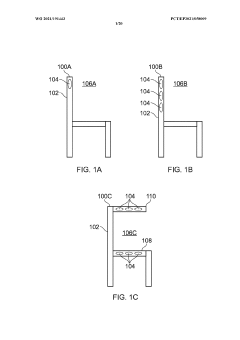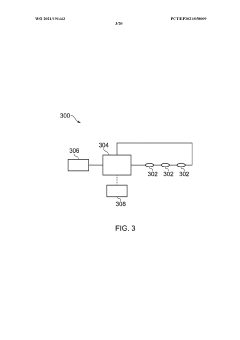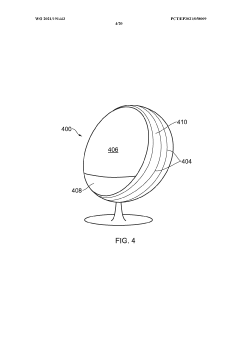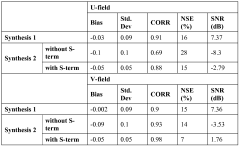Exploring Schumann Resonance for Weather Prediction
Schumann Resonance Background and Objectives
Schumann resonances, discovered by physicist Winfried Otto Schumann in 1952, are a set of spectrum peaks in the extremely low frequency (ELF) portion of the Earth's electromagnetic field spectrum. These resonances occur between the Earth's surface and the ionosphere, creating a global electromagnetic resonance phenomenon. The fundamental frequency of Schumann resonances is approximately 7.83 Hz, with harmonics at higher frequencies.
The study of Schumann resonances has gained significant attention in recent years due to its potential applications in various fields, including weather prediction. As global climate change continues to impact weather patterns, there is an increasing need for more accurate and reliable weather forecasting methods. Exploring the relationship between Schumann resonances and weather phenomena offers a promising avenue for enhancing our understanding of atmospheric dynamics and improving weather prediction capabilities.
The primary objective of this research is to investigate the potential of Schumann resonances as a tool for weather prediction. By analyzing the variations in Schumann resonance parameters, such as frequency, amplitude, and phase, researchers aim to identify correlations with atmospheric conditions and weather patterns. This approach could potentially provide valuable insights into large-scale atmospheric processes and contribute to the development of more accurate weather forecasting models.
One of the key advantages of using Schumann resonances for weather prediction is their global nature. Unlike localized weather monitoring systems, Schumann resonances provide information about the Earth's electromagnetic environment on a planetary scale. This global perspective could offer unique insights into large-scale weather systems and their interactions, potentially improving long-range weather forecasts and climate predictions.
Furthermore, Schumann resonances are sensitive to various atmospheric phenomena, including lightning activity, ionospheric disturbances, and solar-terrestrial interactions. By studying these relationships, researchers hope to gain a deeper understanding of the complex interplay between different atmospheric layers and their influence on weather patterns. This holistic approach to weather prediction could lead to more comprehensive and accurate forecasting models.
As technology advances, the ability to measure and analyze Schumann resonances with greater precision has improved significantly. This progress has opened up new possibilities for integrating Schumann resonance data into existing weather prediction systems. The ultimate goal is to develop a robust and reliable method that combines traditional meteorological data with Schumann resonance observations to enhance weather forecasting accuracy and extend prediction timelines.
In conclusion, exploring Schumann resonances for weather prediction represents an innovative approach to addressing the challenges of modern meteorology. By leveraging this global electromagnetic phenomenon, researchers aim to unlock new insights into atmospheric dynamics and improve our ability to predict and understand weather patterns on a global scale.
Weather Prediction Market Analysis
The weather prediction market has experienced significant growth in recent years, driven by increasing demand for accurate forecasts across various sectors. The global weather forecasting market was valued at approximately $1.6 billion in 2020 and is projected to reach $2.7 billion by 2025, with a compound annual growth rate (CAGR) of 10.3%. This growth is primarily attributed to the rising need for precise weather information in industries such as agriculture, aviation, energy, and transportation.
The market for weather prediction services can be segmented into short-range, medium-range, and long-range forecasts. Short-range forecasts, typically covering periods up to 7 days, dominate the market due to their higher accuracy and immediate applicability. Medium-range forecasts (7-15 days) and long-range forecasts (beyond 15 days) are gaining traction, particularly in sectors requiring advanced planning, such as agriculture and renewable energy.
Geographically, North America holds the largest market share, followed by Europe and Asia-Pacific. The United States, in particular, leads the market due to its advanced meteorological infrastructure and high adoption of weather forecasting services across industries. However, the Asia-Pacific region is expected to witness the fastest growth, driven by increasing investments in weather prediction technologies and the growing awareness of climate change impacts.
Key industry verticals driving the demand for weather prediction services include agriculture, aviation, energy, marine, and transportation. The agriculture sector, for instance, relies heavily on accurate weather forecasts for crop planning, irrigation scheduling, and pest management. The aviation industry requires precise weather information for flight planning and safety, while the energy sector uses weather predictions for demand forecasting and renewable energy production optimization.
The market is characterized by the presence of both established players and innovative startups. Major companies in the weather prediction market include AccuWeather, The Weather Company (an IBM Business), DTN, and Weathernews Inc. These companies are continuously investing in advanced technologies such as artificial intelligence, machine learning, and big data analytics to improve forecast accuracy and provide value-added services.
Emerging trends in the weather prediction market include the integration of Internet of Things (IoT) devices for real-time data collection, the use of cloud computing for processing vast amounts of meteorological data, and the development of mobile applications for personalized weather information delivery. The exploration of novel techniques, such as using Schumann Resonance for weather prediction, represents a potential disruptive innovation in this field, which could further expand the market and improve forecast accuracy.
Current Challenges in SR-based Weather Forecasting
Despite the potential of Schumann Resonance (SR) for weather prediction, several significant challenges currently hinder its widespread adoption and effectiveness in meteorological applications. One of the primary obstacles is the complexity of isolating and interpreting SR signals amidst various sources of electromagnetic noise. Urban environments, in particular, pose difficulties due to the abundance of man-made electromagnetic interference, which can mask or distort the subtle SR signals.
Another challenge lies in the limited spatial resolution of SR measurements. The global nature of SR makes it challenging to pinpoint localized weather phenomena accurately. This limitation restricts the ability to provide detailed, region-specific weather forecasts solely based on SR data, necessitating integration with other meteorological tools and techniques.
The temporal variability of SR signals presents an additional hurdle. Fluctuations in SR parameters can occur due to various factors unrelated to weather, such as solar activity or changes in the ionosphere. Distinguishing weather-related changes from these background variations requires sophisticated analysis techniques and long-term data collection, which are not yet fully developed or standardized across the meteorological community.
Furthermore, the relationship between SR parameters and specific weather patterns is not yet fully understood. While correlations have been observed between SR characteristics and certain meteorological phenomena, the causal mechanisms and predictive power of these relationships remain subjects of ongoing research. This knowledge gap hampers the development of reliable forecasting models based on SR data.
The lack of a comprehensive, global network of SR monitoring stations also impedes progress in this field. Establishing and maintaining such a network requires significant investment in infrastructure and international cooperation, which has not yet been fully realized. This limitation results in gaps in data coverage and reduces the overall effectiveness of SR-based weather prediction on a global scale.
Lastly, the integration of SR data into existing weather forecasting models and systems poses technical and methodological challenges. Developing algorithms and frameworks that can effectively combine SR information with traditional meteorological data sources is a complex task that requires interdisciplinary expertise and extensive validation processes.
Existing SR-based Weather Prediction Methods
01 Schumann resonance devices for health and wellness
Various devices are designed to generate or utilize Schumann resonance frequencies for potential health benefits. These devices aim to simulate the natural electromagnetic frequencies of the Earth to promote relaxation, improve sleep quality, and enhance overall well-being. Some implementations include wearable devices, room-based generators, and portable units that emit Schumann resonance frequencies.- Schumann resonance devices for health and wellness: Various devices are designed to generate or utilize Schumann resonance frequencies for potential health benefits. These devices aim to simulate the natural electromagnetic frequencies of the Earth to promote relaxation, improve sleep quality, and enhance overall well-being. Some implementations include wearable devices, room-based generators, and portable units that emit Schumann resonance frequencies.
- Schumann resonance in environmental monitoring and prediction: Schumann resonance measurements are utilized in environmental monitoring systems and prediction models. These applications leverage the relationship between Schumann resonance and global lightning activity, atmospheric conditions, and climate patterns. The technology is employed in weather forecasting, climate research, and early warning systems for natural disasters.
- Integration of Schumann resonance in meditation and relaxation tools: Schumann resonance frequencies are incorporated into meditation and relaxation tools to enhance the user experience. These tools may include audio systems, virtual reality environments, or specialized meditation spaces that generate or simulate Schumann resonance frequencies. The aim is to create a more immersive and effective meditation or relaxation practice by aligning with Earth's natural frequencies.
- Schumann resonance in electromagnetic shielding and protection: Technologies are developed to incorporate Schumann resonance principles in electromagnetic shielding and protection devices. These innovations aim to mitigate the potential negative effects of artificial electromagnetic fields while maintaining exposure to beneficial natural frequencies. Applications include protective clothing, building materials, and personal electronic device accessories.
- Schumann resonance-based energy harvesting and power generation: Novel approaches to energy harvesting and power generation utilize Schumann resonance frequencies. These technologies aim to tap into the Earth's natural electromagnetic field as a potential source of clean energy. Proposed applications include small-scale power generation for remote sensors, wearable devices, and other low-power electronics.
02 Schumann resonance in environmental monitoring and prediction
Schumann resonance measurements are used in environmental monitoring systems and weather prediction models. These systems analyze changes in the Earth's electromagnetic field to detect and forecast various phenomena, including seismic activity, atmospheric disturbances, and climate patterns. The technology involves sensors and data processing algorithms to interpret Schumann resonance signals for environmental applications.Expand Specific Solutions03 Integration of Schumann resonance in electronic devices
Electronic devices, such as smartphones, tablets, and smart home systems, are being designed to incorporate Schumann resonance technology. These devices may include features that generate or detect Schumann resonance frequencies, aiming to create a more natural electromagnetic environment for users or to provide additional functionality related to well-being and environmental awareness.Expand Specific Solutions04 Schumann resonance in agriculture and plant growth
Applications of Schumann resonance in agriculture focus on enhancing plant growth and crop yield. Systems and methods are developed to expose plants to Schumann resonance frequencies, potentially stimulating growth, improving nutrient uptake, and increasing resistance to pests and diseases. This technology may be implemented in greenhouses, vertical farming setups, or open-field agriculture.Expand Specific Solutions05 Schumann resonance-based energy harvesting
Innovative energy harvesting technologies are being developed to capture and utilize the energy from Schumann resonance. These systems aim to convert the low-frequency electromagnetic waves of the Earth's resonance into usable electrical energy. Potential applications include powering small electronic devices, sensors, or supplementing renewable energy systems in remote locations.Expand Specific Solutions
Key Players in SR and Weather Prediction
The exploration of Schumann Resonance for weather prediction is in its early developmental stage, with a growing market potential as climate change intensifies the need for accurate forecasting. The technology's maturity is still evolving, with various players contributing to its advancement. Universities like South China University of Technology, Nanjing University, and Colorado State University are conducting fundamental research. Companies such as The Boeing Co. and DTN LLC are exploring practical applications. Research institutions like the University of Bern and Telecom Italia SpA are bridging the gap between academic findings and industry implementation. As the technology progresses, we can expect increased collaboration between academic institutions and commercial entities to refine and validate Schumann Resonance-based weather prediction models.
The Boeing Co.
DTN LLC
Core SR Technologies for Weather Forecasting
- A magnetic field exposure system generating an amplitude-modulated low frequency magnetic field with a carrier frequency of 360 to 450 Hz and a modulation frequency of 0.5 to 100 Hz, with a field strength of 0.5 to 250 mT, specifically designed to expose organic cells or tissues to improve cell survival, proliferation, reduce stress, and enhance well-being.
- A dynamic and adaptive radar tracking system (DARTS) that employs a spectral algorithm to solve a flow equation for motion coefficients using reflective atmospheric data, converting time domain radar data into the frequency domain, and applying motion coefficients to predict future atmospheric conditions, thereby improving storm motion tracking and nowcasting accuracy.
Environmental Impact of SR Monitoring
The monitoring of Schumann Resonance (SR) for weather prediction purposes has potential environmental impacts that warrant careful consideration. As SR monitoring systems become more widespread, their ecological footprint must be evaluated to ensure sustainable implementation.
One primary environmental concern is the installation of SR monitoring stations in remote or ecologically sensitive areas. These stations typically require clearing small patches of land for equipment placement, which may disrupt local ecosystems. However, the footprint of individual stations is generally minimal, often less than 100 square meters. Proper site selection and environmental impact assessments can mitigate potential harm to flora and fauna.
Energy consumption is another factor to consider. SR monitoring equipment operates continuously, requiring a constant power supply. In remote locations, this often necessitates the use of solar panels or other renewable energy sources. While this approach minimizes carbon emissions, the production and eventual disposal of these energy systems should be factored into the overall environmental impact assessment.
Electromagnetic radiation emitted by SR monitoring equipment is generally low-power and non-ionizing, posing minimal risk to surrounding wildlife. However, long-term studies on the effects of continuous low-level electromagnetic fields on local ecosystems are limited and may warrant further investigation.
Data transmission from remote SR monitoring stations to central processing facilities often relies on satellite or cellular networks. The energy consumption and infrastructure requirements for these communication systems contribute to the overall environmental footprint of SR monitoring networks. Optimizing data transmission protocols and leveraging existing communication infrastructure can help reduce this impact.
The potential benefits of improved weather prediction through SR monitoring must be weighed against these environmental considerations. More accurate forecasts could lead to better preparedness for extreme weather events, potentially reducing the environmental damage caused by natural disasters. Additionally, enhanced climate modeling capabilities could contribute to more effective climate change mitigation strategies.
As SR monitoring technology advances, there is an opportunity to develop more environmentally friendly equipment and practices. This may include the use of biodegradable materials in sensor construction, implementing energy-efficient data processing algorithms, and designing easily recyclable components to minimize electronic waste.
In conclusion, while the environmental impact of SR monitoring for weather prediction is relatively low compared to many other technological deployments, it is crucial to continually assess and minimize its ecological footprint. Balancing the potential benefits of improved weather forecasting with responsible environmental stewardship will be key to the sustainable expansion of SR monitoring networks.
Data Integration and AI in SR Forecasting
The integration of Schumann Resonance (SR) data with advanced artificial intelligence (AI) techniques represents a significant leap forward in weather prediction capabilities. This synergy between natural electromagnetic phenomena and cutting-edge computational methods offers promising avenues for enhancing forecasting accuracy and reliability.
At the core of this integration lies the vast amount of SR data collected from global monitoring stations. These stations continuously measure the resonant frequencies of the Earth-ionosphere cavity, providing a wealth of information about the planet's electromagnetic environment. The challenge lies in effectively processing and interpreting this data to extract meaningful weather-related insights.
Machine learning algorithms, particularly deep learning models, have shown remarkable potential in identifying complex patterns within SR data that correlate with atmospheric conditions. Convolutional Neural Networks (CNNs) and Long Short-Term Memory (LSTM) networks have been successfully employed to analyze the spectral characteristics of SR signals and their temporal variations. These AI models can detect subtle changes in SR patterns that may precede significant weather events, offering early warning capabilities for phenomena such as severe storms, hurricanes, or even seismic activities.
The integration process involves several key steps. First, raw SR data undergoes preprocessing to remove noise and normalize the signals. This cleaned data is then fed into AI models trained on historical SR measurements and corresponding weather patterns. The models learn to recognize the intricate relationships between SR fluctuations and atmospheric dynamics, enabling them to make predictions based on real-time SR inputs.
One of the most promising aspects of this integration is the potential for multi-modal forecasting. By combining SR data with traditional meteorological measurements, satellite imagery, and other environmental sensors, AI systems can create a more comprehensive picture of atmospheric conditions. This holistic approach allows for more nuanced and accurate predictions, especially for complex weather phenomena that may be difficult to forecast using conventional methods alone.
However, challenges remain in fully realizing the potential of SR-AI integration in weather forecasting. These include the need for more extensive and higher-quality SR data sets, the development of more sophisticated AI models capable of handling the complexity of global weather systems, and the integration of SR-based predictions into existing forecasting frameworks. Overcoming these challenges will require continued collaboration between atmospheric scientists, data scientists, and AI researchers.
As this field evolves, we can expect to see increasingly accurate and timely weather predictions, benefiting sectors ranging from agriculture and energy to disaster management and public safety. The ongoing refinement of AI techniques and the expansion of SR monitoring networks will likely lead to further breakthroughs in our ability to understand and forecast Earth's weather patterns.







